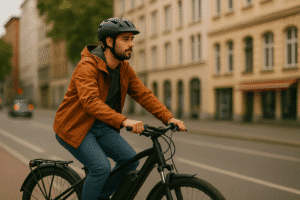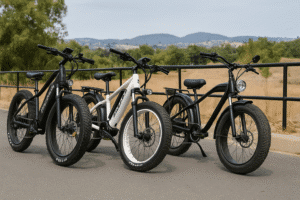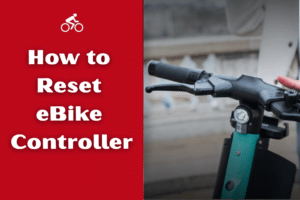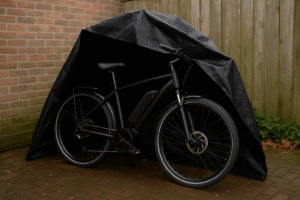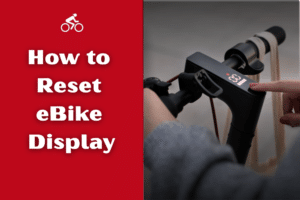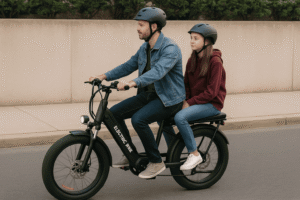Electric bikes are generally low-maintenance, but when something goes wrong, it helps to know what to check first. Whether your e-bike won’t turn on, the brakes feel off, or the battery seems dead, most problems have simple, at-home fixes.
This guide covers the most common issues and how to troubleshoot them step-by-step, based on recurring questions from real riders and problems often discussed in e-bike forums and user communities. You’ll also find links to deeper repair tutorials if you need more help.
Battery Not Working or Charging?
Battery issues are by far the most common problems e-bike riders face. If your bike won’t turn on or shuts off suddenly, the battery is the first place to investigate. Here are the key things to check.
Battery shows full but doesn’t power the bike
If your battery indicator says it’s fully charged but the bike still won’t turn on, there may be a disconnect between the battery and the controller. This can happen due to corroded contacts, a tripped fuse, or internal imbalance in the battery cells.
Remove the battery and inspect the connectors for dirt, rust, or looseness. Sometimes, just cleaning the terminals and reseating the battery fixes the issue.
If that doesn’t help, the battery could have enough voltage to appear “charged” but not enough to power the motor. You can follow this guide to diagnose a fully charged battery that’s not working and rule out common causes.
How to test if your battery is working
A visual indicator or display isn’t enough to confirm battery health. Use a multimeter to check the voltage directly. For example, a healthy 48V battery should measure around 54.6 volts when fully charged. If it reads significantly lower, the battery might be deeply discharged or failing.
This quick battery testing tutorial shows how to measure voltage, understand the numbers, and know when it’s time for a replacement.
Battery isn’t charging at all
If your battery doesn’t respond when plugged in, or your charger light stays green without charging, the battery might be in protection mode. This can happen after deep discharge, overheating, or long-term storage.
Try pressing and holding the power button on the battery for several seconds. Some batteries also have a small reset switch near the charge port. You can follow this step-by-step battery reset guide to get things running again.
If that still doesn’t work, test your charger too. A faulty charger can mimic battery failure.
Charging a battery without the original charger
It’s possible to charge an e-bike battery without the original charger, but it has to be done carefully. Using the wrong voltage or connector type can cause serious damage.
Some riders use universal chargers or connect through the battery’s BMS port, but this depends on the battery brand and configuration.
If you’re in this situation, check out our article on how to charge your e-bike battery without a charger for safe alternatives and what to avoid.
Storing your battery in hot conditions
Storing your battery in a hot garage or car can shorten its lifespan. Lithium-ion batteries degrade faster when exposed to high temperatures. Even if it still works, performance and capacity will decline over time.
To protect your battery, keep it in a cool, dry place whenever possible. We cover how to store your e-bike battery safely and explain the risks of heat exposure during storage in more detail.
Display or Controller Not Responding
If your e-bike turns on but the display doesn’t work, shows an error code, or stays frozen, the issue often lies with the controller or wiring. Sometimes a simple reset can solve the problem without any tools or part replacements.
Display won’t turn on or is stuck
A blank or unresponsive display can be caused by a loose connector, moisture inside the housing, or firmware glitches. Start by turning the bike off, unplugging the display (if it’s removable), and checking the cable connections for damage or corrosion. Reconnect everything tightly and power the bike back on.
If the screen stays blank or frozen, try a factory reset. Most displays have a reset combination involving the power and mode buttons.
You can refer to our step-by-step guide on resetting an e-bike display based on your model type.
Controller not responding or behaving erratically
If your bike turns on but the motor doesn’t respond, or if pedal assist and throttle act strangely, the issue may be with the controller. The controller regulates power between the battery, motor, and other components. Power surges, moisture, or loose connections can cause it to fail.
Try resetting the controller, especially if your system includes a button or diagnostic code function. If you’re unsure how, this e-bike controller reset guide walks you through the process safely.
Strange motor response or delayed acceleration
An unresponsive motor or delayed pedal assist may also be tied to the torque sensor. This sensor helps the controller determine how much power to send based on your pedaling effort. If it’s dirty, misaligned, or faulty, the bike may feel sluggish or jerky.
To learn how a torque sensor works and how to tell if yours is failing, check out our breakdown of what a torque sensor does on an e-bike and how to troubleshoot basic sensor issues.
Brake and Speed Issues
If your e-bike doesn’t stop smoothly or feels slower than expected, it could be related to your brake setup or built-in speed restrictions. Both are common concerns, especially for riders who upgrade components or ride in hilly areas.
Brakes feel soft or too tight
Hydraulic brakes can lose effectiveness over time due to air in the lines, worn pads, or misalignment. If your brakes feel spongy, don’t engage properly, or rub against the rotor, they likely need adjustment.
Start by checking the brake levers and calipers. Look for uneven spacing between the pads and the disc. If the pads are worn or the fluid line feels soft, you may need to bleed the brakes or realign the caliper. For step-by-step help, see our tutorial on adjusting hydraulic brakes on an electric bike.
Regular brake maintenance is essential not just for stopping power, but also for overall safety. If you’re unsure what else to check, our general e-bike maintenance guide covers all the basics.
E-bike feels slower than it should
If your e-bike suddenly feels underpowered, check your assist level, battery voltage, and tire pressure first. But if everything seems normal and it still won’t go beyond a certain speed, you may have hit the factory speed limiter.
Most e-bikes sold in the U.S. or EU come with a speed cap for legal reasons, typically 20 mph for Class 2 bikes and 28 mph for Class 3. If your bike isn’t reaching these speeds, the limiter may be set too low or the controller could be misconfigured.
To learn how to safely increase your speed, read our guide on how to make your e-bike go faster. It explains what settings to check and what trade-offs to expect, like battery drain or legal risks.
Can you remove the speed limiter?
Yes, many e-bikes allow you to adjust or bypass the speed limiter through the display or controller settings. However, this may void your warranty or make your bike illegal to ride on public roads, depending on your local laws.
If you’re curious about your options, we explain how to remove the speed limiter on an electric bike, what tools you may need, and how to do it responsibly.
Startup and Key Issues
Sometimes the most frustrating problems are the simplest: your e-bike won’t start, and you either lost the key or the bike just doesn’t respond. The good news is that in many cases, you can still get moving without replacing any major parts.
E-bike won’t start and there’s no key
If your e-bike uses a key ignition system and you’ve lost the key, don’t panic. Many models allow you to bypass the key ignition safely, but it depends on the type of controller and battery system your bike uses.
Some bikes have a manual power button hidden near the battery or on the frame. Others can be started by connecting the battery directly to the controller using a jumper or bypass wire.
If you’re unsure whether your model supports this, check your manual first. We’ve also outlined the safest methods in our article on how to start an e-bike without a key.
If the key is not lost but the bike still won’t power up, double-check the battery seating, fuse, and all connectors before assuming it’s an ignition issue.
Final Tips Before You Call a Mechanic
Many e-bike issues can be fixed at home, but there are times when a professional is the safer route. Here are a few final checks to consider before booking a repair:
- Check the basics first. Loose connectors, tripped fuses, and low battery voltage are often the real culprits behind bigger symptoms.
- Take note of error codes. If your display shows a code or flashing pattern, look it up in your user manual. It could point directly to the issue.
- Inspect for water damage. Moisture in the battery compartment, controller box, or display can cause intermittent failures.
- Avoid forced DIY fixes. If you’re not sure how to reset a controller or bypass a key switch, using the wrong method can cause permanent damage.
- Bookmark reliable guides. Many problems repeat over time, and keeping how-to resources on hand saves time later.
Conclusion
E-bikes are built for convenience, but that doesn’t mean problems won’t come up. From battery failures to controller issues, most of the common complaints can be diagnosed and often fixed at home with the right guidance.
By understanding how your e-bike works and knowing where to look first, you’ll avoid unnecessary service costs and keep your ride on the road longer.
And when you do need deeper help, our troubleshooting guides are always here to walk you through each fix, step by step.
Looking for more? Check out our full library of e-bike maintenance tips and repair guides to stay ahead of the most common issues.
Al Amin Morshed is the founder of BoltBikers and a seasoned e-bike reviewer with years of hands-on experience testing electric bikes. As a long-time e-bike enthusiast, he combines real-world riding insights with in-depth research to create honest, helpful content for riders of all levels. Through BoltBikers, Morshed aims to make e-biking more accessible, practical, and enjoyable – whether you’re a new rider or a daily commuter looking for the best gear.
